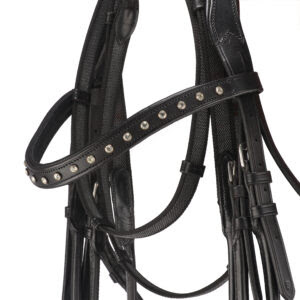Buy Best Horse & Horse Riding Accessories at Equine World
Using a modified bridle design has a significant impact on whole horse locomotion–front and hindlimb–not just the head.
Recent scientific advances have seen an increase in performance-based research, particularly in the sport horse world where a podium finish can depend on the smallest of margins. The findings from the sport horse research can be translated to the racing Thoroughbred where the shortest distance can put you first past the post. All items of training tack and equipment have found themselves under scientific scrutiny, with some unexpected results which could have significant effects on racehorse performance. Perhaps one of the most surprising discoveries was the effect that bridle fit and design has on the locomotor apparatus of the horse (biomechanics). The bridle is a neglected item of tack which has, until now, received little scientific attention.
• Ahead of the game
As well as improving locomotion, these findings could have a significant benefit when it comes to resolving common issues affecting race performance, such as oral lesions in the commissures (corners) of the lips, tongue lolling and hanging, as well as steering or control issues. Research indicates that these behaviors are likely to occur as a result of the horse seeking relief from bridle pressure and instability. Tongue ties or Australian nosebands are two examples of gadgets traditionally used to remedy these issues, but they have their own welfare and pressure-inducing concerns. A more effective solution would be to remove the primary cause of discomfort which leads to the negative or undesirable behavior by using a modified pressure-relieving bridle design.
• Pressure head
Research using a calibrated pressure sensor mat, which was positioned beneath all parts of the bridle, revealed interesting findings and disproved some long-held assumptions. It had long been thought that horses experience bridle pressure directly on their poll. In contrast, the research team found no significant areas of pressure over the poll. Instead, areas of high peak pressure were located at the base of the ears in the region where the browband attaches to the headpiece. Anatomically this corresponds to the. It is available at Equine World
temporomandibular joint (TMJ). The TMJ is an essential part of the physiological apparatus, associated with the swallow reflex and the hyoid apparatus (see anatomy panel). The location of pressure (base of the ear and TMJ) was consistent in all commonly used headpieces and occurred at the same moment in the stride, regardless of the make or design. The research team also used gait analysis where markers are placed on the horse’s anatomical locations (joints), allowing locomotion to be measured. This enabled them to quantify how front and hindlimb kinematics altered, revealing an increased range of limb motion when the peak pressures in the anatomical zones were removed. Buy Horse Boots at equine world
Similar to the headpiece, the timing and location of the noseband pressures were consistent in every stride cycle. During locomotion, noseband pressures differed relative to the horse’s head position. When the head was positioned more horizontally (for example when galloping), the frequently- chosen caves son exerted significantly higher pressures on the lower edge of the noseband, which was associated with a reduced range of motion. Previous studies from this group have shown that reducing high pressures beneath a girth and saddle is associated with improved locomotion. The same relationship is seen with the Horse bridles; areas of high pressures beneath the headpiece and noseband have a significant effect on equine locomotion and cause the horse to develop a compensatory locomotor strategy.


Comments
Post a Comment